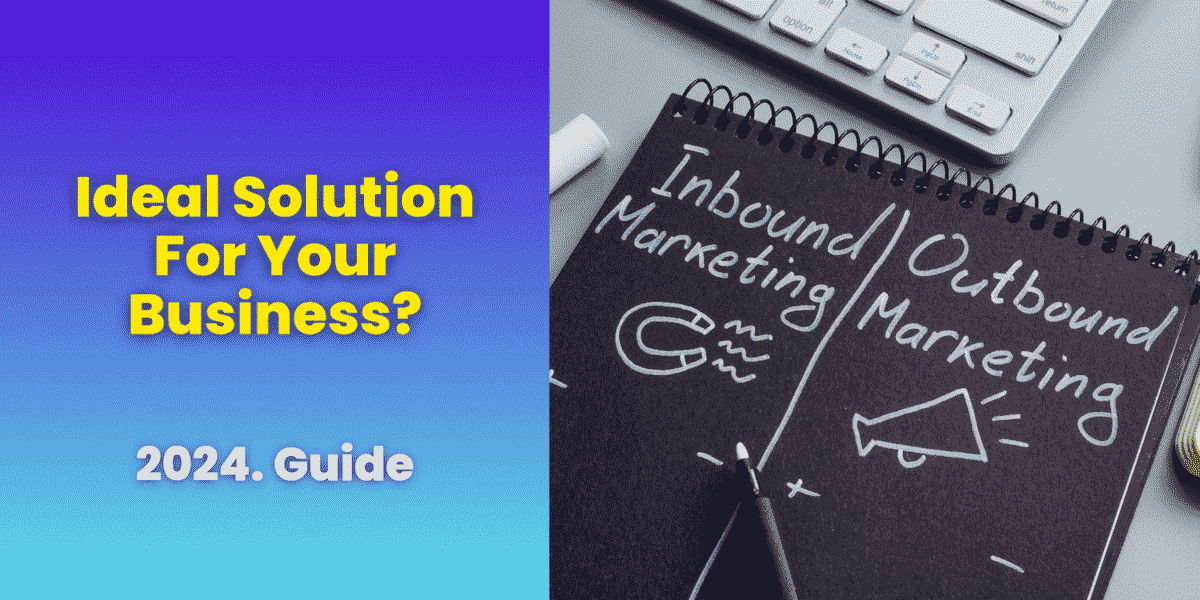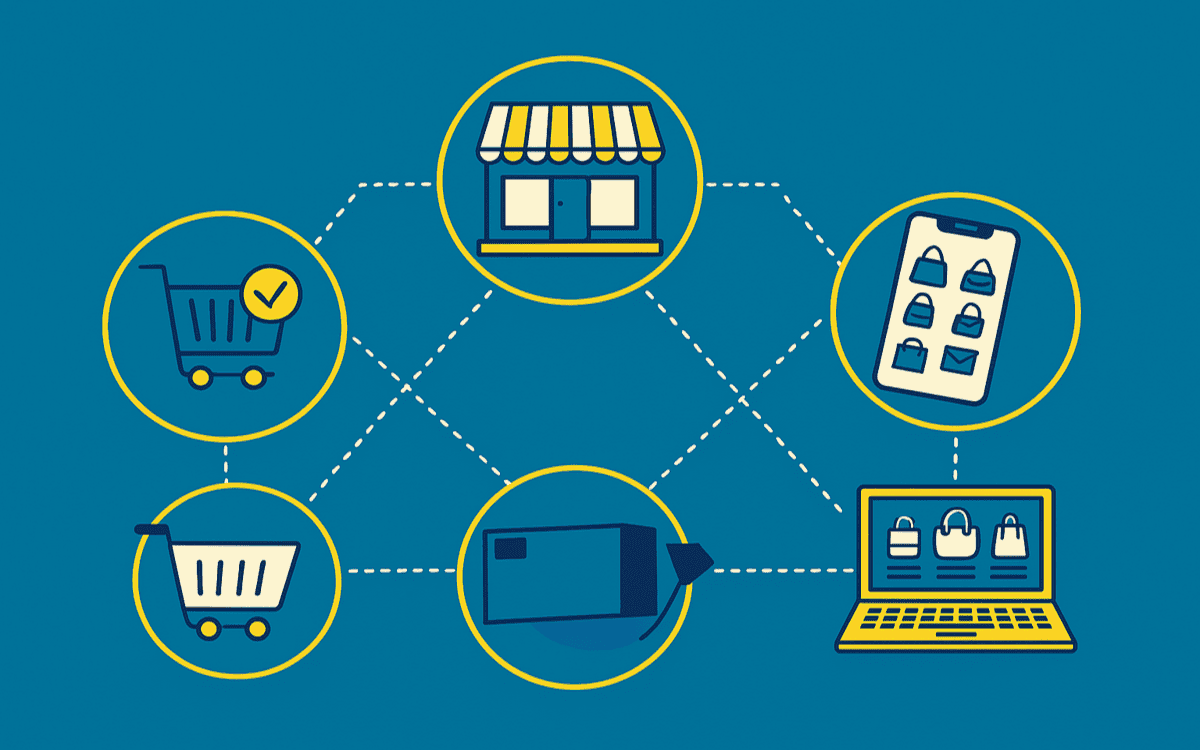In today’s fast-paced digital marketing landscape, distinguishing between inbound and outbound leads is pivotal for businesses striving to connect with their target prospects more effectively and drive enhanced sales outcomes. This in-depth guide is designed to unravel the intricacies of both lead generation strategies, equipping you with the insights necessary to tailor these approaches to your business’s unique objectives.
Whether your aim is to captivate potential customers through compelling content on your blog, refine your email marketing strategies to better meet your audience’s needs, or employ outbound tactics to proactively engage those who could benefit most from your offerings, this article promises to provide you with the knowledge required to navigate the complex terrain of contemporary lead generation.
The focus here is not just on attracting prospects but on doing so in a way that aligns with their preferences and behaviors, thereby fostering more meaningful connections and ultimately, better business outcomes. Inbound leads, generated through strategies that pull potential customers towards your business—like informative blog posts, optimized email campaigns, and effective use of social media—offer a way to build trust and establish your brand as a thought leader in your industry.
By delving into the advantages and potential drawbacks of each approach, businesses can develop a nuanced understanding of how to best use these strategies to their advantage. This guide aims to help you identify the right mix of inbound and outbound tactics that will not only attract the right customers but scale up your business to heights you couldn’t dream of.
Table of Contents
- What are Inbound Leads?
- What are Outbound Leads?
- What are the Advantages of Inbound Lead Generation?
- What are the Disadvantages of Inbound Leads?
- What are the Advantages of Outbound Lead Generation?
- What are the Disadvantages of Outbound Leads?
- What are the Examples of Inbound Lead Generation Techniques?
- What are the Examples of Outbound Lead Generation Techniques?
- Which Factors Should You Consider When Choosing Between Inbound/Outbound Lead Generation?
- What Are the Biggest Differences Between These Two Tactics?
- Why Is Combining Inbound and Outbound Lead Strategies Important?
- Conclusion
- How to Outsource Lead Generation in 2024?
- Frequently Asked Questions (FAQ)
What are Inbound Leads?
Inbound leads are those potential customers who make the first move towards engaging with your business, often after discovering you through various digital marketing strategies. This initiation usually happens when prospects find your content via search engines, encounter your posts on social media, or visit your website after reading a compelling blog article. The beauty of inbound leads lies in their self-motivated interest in what you have to offer, making them a highly valuable asset for any business.
Because these individuals have actively sought out information related to your products or services, they are already further along in the buyer’s journey. This predisposition significantly increases the likelihood of conversion, as you’re not convincing them from scratch but rather, guiding them the rest of the way. Utilizing SEO effectively ensures your website appears prominently in search results, better positioning your business to capture these leads. Similarly, maintaining an engaging presence on social media and distributing informative email newsletters can nurture this interest, drawing prospects closer to a purchasing decision.
What are Outbound Leads?
Outbound leads, on the other hand, are generated through proactive efforts by the company to reach potential customers. This traditional approach to lead generation includes techniques like telemarketing, cold calling, and direct email campaigns, where the business initiates contact with prospects who might not be actively searching for their products or services. All the aforementioned techniques can lead to numerous benefits of outsourcing lead generation.
The objective here is to introduce your offerings to a broader audience, making them aware of solutions they might not have realized they needed. Outbound lead generation allows companies to target specific demographic or psychographic segments, making it possible to tailor messages that resonate with the intended audience.
What are the Advantages of Inbound Lead Generation?
Cost-Effectiveness
Inbound lead generation stands out as a highly cost-effective way to attract and acquire new customers. By leveraging quality content, search engine optimization (SEO), and social media engagement, businesses can significantly lower their customer acquisition costs compared to the expenses associated with traditional advertising methods. This strategy utilizes the company’s website and blog as central hubs for information and resources that draw potential customers in. You can read more about whether lead generation is actually worth it.
Higher Conversion Rates
Inbound leads typically exhibit higher conversion rates, primarily because these prospects have already demonstrated an interest in your product or service by the time they engage with your business. This initial interest, sparked by encountering your content or finding your website through a search query, means that inbound leads are often more qualified and closer to making a purchase decision. The right content can help educate and inform prospects, making them more likely to convert into paying customers. Sales teams can then focus their efforts on these warm leads, using email and personalized follow-ups to address specific needs and concerns, ultimately leading to more successful conversions.
Targeted Audience
Inbound marketing strategies excel in reaching a targeted audience in a way that feels natural and unobtrusive. By optimizing content for specific search queries and using social media platforms to engage with niche communities, businesses can ensure that their marketing efforts are seen by the right people.
This precise targeting helps in attracting prospects who are genuinely interested in the services or products offered, increasing the likelihood of engagement and conversion. Through detailed blog posts, informative email newsletters, and active social media participation, companies can build a presence that resonates with their ideal customer base, making it easier to attract leads that are a good fit for their business.

Long-Term Relationship Building
The inbound approach to lead generation is not just about attracting leads; it’s also about building and nurturing relationships over time. This method contributes significantly to customer loyalty and long-term brand engagement. By consistently providing valuable content through blogs, email, and social media, businesses can establish themselves as trusted authorities in their field.
This trust fosters a sense of loyalty among prospects and existing customers alike, encouraging repeat business and referrals. The quality and relevance of the content shared play a crucial role in keeping the audience engaged and interested in the brand, creating opportunities for businesses to deepen these relationships and secure a loyal customer base that supports long-term sales and growth.
What are the Disadvantages of Inbound Leads?
Time-Consuming
Generating inbound leads is indeed a time-consuming endeavor, primarily due to the necessity of creating high-quality, engaging content that resonates with your target audience. Beyond content creation, there’s also a significant investment required in SEO optimization to ensure that your content ranks well in search engine results, and in managing various social media platforms to maintain and grow your online presence. This comprehensive approach demands a consistent and ongoing effort to produce, optimize, and share content that attracts and retains the interest of potential leads.
Competition
The digital landscape is incredibly competitive, with countless businesses across all sectors striving to capture the attention of similar audience segments. In such a crowded market, distinguishing your brand and making your voice heard above the noise becomes a formidable challenge. This intense competition necessitates innovative strategies and creative content that not only appeals to your target demographic but also offers them genuine value, setting your business apart from competitors.
Limited Control
Relying on inbound leads introduces a level of uncertainty regarding the volume and timing of lead generation, as these factors are largely dependent on customer actions and interests. Businesses often find themselves at the mercy of the market’s fluctuating demands, with little ability to predict or influence how and when potential customers will engage with their content. This lack of control can make planning and scaling marketing efforts more challenging, requiring businesses to be flexible and adaptive in their strategies to capture inbound leads effectively.
What are the Advantages of Outbound Lead Generation?
Control over Lead Generation
Outbound strategies empower businesses with direct control over their lead generation efforts, enabling a proactive approach to identifying and engaging potential customers through targeted outreach.
Quick Results
Outbound lead generation methods are designed for speed, offering businesses the ability to see immediate impacts on their sales efforts, which is crucial for rapid growth and meeting short-term objectives.
Effective for Specific Goals
These strategies excel in their capacity to be finely tuned for specific objectives, whether it’s increasing sales in a particular product line or boosting event attendance, making them highly effective for targeted campaigns.
Market Expansion
Utilizing outbound lead generation techniques allows businesses to actively pursue expansion into new markets or reach demographics previously untapped, broadening their customer base and opening up new avenues for growth.
What are the Disadvantages of Outbound Leads?
Cost-Intensive
Outbound lead generation, while effective in reaching a broad audience quickly, often comes with a significant price tag due to the need for extensive advertising and promotional campaigns. This approach demands a substantial upfront investment to cover the costs of direct mail, paid media, telemarketing, and other outreach activities, making it a less viable option for businesses operating on tight marketing budgets. The reliance on these costly strategies requires careful planning and budget management to ensure a favorable return on investment.
Lower Conversion Rates
The nature of outbound lead generation means reaching out to potential customers without prior expressed interest, which can result in lower conversion rates compared to inbound methods. Since the outreach is unsolicited, there’s a higher likelihood that recipients may not be in the market for the product or service at the time of contact, leading to a greater number of rejections or ignored communications. This challenge necessitates more strategic targeting and personalized messaging to improve engagement and increase the chances of conversion.
Intrusiveness
Outbound lead generation tactics, such as cold calling or unsolicited emails, run the risk of being perceived as intrusive by recipients, which can negatively impact a brand’s reputation. This perception of intrusiveness can alienate potential customers, making them less likely to engage with the brand in the future. To mitigate this risk, businesses must tread carefully, ensuring their outbound strategies are well-targeted, respectful of the recipient’s preferences, and compliant with legal regulations regarding unsolicited outreach.
What are the Examples of Inbound Lead Generation Techniques?
SEO
Search Engine Optimization (SEO) is a critical strategy for enhancing your website’s visibility in search engine results, targeting users who are actively seeking products or services like yours. By optimizing site content, structure, and on-page elements like keywords and meta descriptions, businesses can significantly increase their site’s attractiveness to search engines, thereby improving their chances of being found by potential customers. This process not only boosts website traffic but also enhances the quality of visitors, as it connects you with users who have a genuine interest in what you offer.
Content Marketing
Content marketing involves the creation and sharing of valuable content to attract, engage, and retain a clearly defined audience. By consistently providing content that is relevant and useful to your target audience, your brand can establish itself as an authority in your field, building trust and credibility with potential customers. This strategy not only helps in attracting new leads but also in maintaining a lasting relationship with your audience, encouraging repeat visits and conversions.

Social Media Management
Social media management utilizes platforms like Facebook, Twitter, and Instagram to build relationships and interact directly with potential and existing customers. Through strategic posting, engaging content, and community management, businesses can create a dynamic online presence that attracts new leads while fostering loyalty among followers. This approach allows for real-time engagement and feedback, making it an invaluable tool for understanding your audience and tailoring your offerings to meet their needs.
E-mail Marketing
E-mail marketing is a direct and personalized way to reach your target audience, sending targeted messages to subscribers who have expressed interest in your brand. By crafting well-designed emails that offer value through informative content, exclusive offers, or updates about your products or services, you can nurture your leads through the sales funnel, encouraging closer engagement and higher conversion rates. This method remains one of the most effective ways to maintain communication with your audience, providing them with relevant information that caters to their interests and needs.
Landing Pages
Landing pages are specially designed web pages created with the sole purpose of converting visitors into leads. These pages offer specific information or offers in exchange for visitors’ contact information, making them a powerful tool for lead generation. By focusing on a single call to action and removing distractions, landing pages can effectively guide visitors towards making a decision, whether it’s downloading a white paper, signing up for a webinar, or making a purchase.
Programmatic Advertising
Programmatic advertising revolutionizes the way ad space is bought, using automated technology to target highly specific audiences with precision. This method allows for the real-time purchase and management of digital advertisements, ensuring that your ads are displayed to the right people at the right time. By leveraging data and algorithms, programmatic advertising can significantly increase the efficiency and effectiveness of your advertising efforts, maximizing the return on your investment and connecting you with potential leads who are most likely to be interested in your products or services.
What are the Examples of Outbound Lead Generation Techniques?
Telemarketing
Telemarketing involves direct phone communication with potential customers to introduce them to your products or services. This personalized approach allows for immediate feedback and the opportunity to address questions or concerns on the spot, enhancing the potential for lead conversion. By leveraging skilled telemarketers who can effectively communicate the value of your offerings, businesses can significantly increase their customer base and direct sales efforts more efficiently.
Cold Calling
Cold calling is the practice of making unsolicited phone calls to individuals or businesses to present your products or services. Despite its reputation for being intrusive, when executed with research and a clear understanding of the target audience’s needs, cold calling can be an effective strategy for generating new leads. It requires a well-prepared script and a resilient attitude, as success often comes after navigating through initial rejections to find interested prospects.
Creating Events
Organizing events like webinars, conferences, or workshops serves as a dynamic platform for attracting potential leads and engaging with them in a meaningful way. These events provide an opportunity to showcase your brand’s expertise, share valuable insights, and directly interact with an interested audience.
Direct Mails
Direct mail involves sending physical marketing materials, such as brochures, flyers, or catalogs, directly to the homes or offices of potential customers. This tangible form of marketing can create a lasting impression, offering something physical that recipients can refer back to.
Traditional Advertising
Traditional advertising uses channels like TV, radio, print media, and billboards to promote products or services to a wide audience. Despite the rise of digital marketing, traditional advertising remains a powerful tool for building brand awareness and reaching demographics less accessible through online platforms. By crafting memorable and engaging ads, businesses can tap into the broad reach of traditional media to attract new customers and reinforce their brand presence in the market.
Which Factors Should You Consider When Choosing Between Inbound/Outbound Lead Generation?
Identifying Target Audiences
Understanding who your ideal customers are and which lead generation method is more likely to reach them effectively. Finding an audience in which every customer will want what you are offering is key to success when finding leads.
Determining Budget
Assessing how much you can allocate to lead generation efforts and which method offers the best ROI for your investment. If you want to keep your budget tight, inbound leads might be a better idea, but with lesser ROI.
Setting your Goals
Defining what you aim to achieve with your lead generation campaign, such as increasing brand awareness or driving sales. Regarding on your services/ product, you will have different goals.
Resources at Disposal
Evaluating the resources, you have available, including staff expertise and technological tools, to implement your chosen lead generation strategy. As we have mentioned before, having more resources for lead generation will usually lead to outbound leads strategy, finding new potential clients.
Find out more about lead generation vs demand generation, lead generation vs brand awareness and demand generation vs brand awareness and find out which model suits you best.
What Are the Biggest Differences Between These Two Tactics?
Cost of Campaigns
Inbound lead generation is often less expensive in the long run compared to outbound, which requires upfront investment in advertising and promotional activities.
Control of Engagement
In inbound lead generation, the customer takes the initial step to engage with your brand, while in outbound, the marketer initiates the contact.
The Value of Marketing Assets
Inbound lead generation tactics, like content marketing and SEO, build valuable long-term assets for your company that continue to generate leads over time, offering a longer-term ROI compared to the more immediate but short-lived impact of outbound tactics.
Why Is Combining Inbound and Outbound Lead Strategies Important?
Synergy
Combining inbound and outbound lead generation strategies can create a synergistic effect, where the strengths of one approach can complement the weaknesses of the other, leading to a more comprehensive and effective overall strategy.
Maximizing Reach
A combined strategy allows businesses to cast a wider net, reaching potential customers at different stages of the buying process and through various channels, thereby maximizing the potential for lead generation and conversions.
Conclusion
Understanding and effectively utilizing both inbound and outbound leads are crucial for any successful marketing strategy. Each approach offers unique benefits and caters to different aspects of customer acquisition and engagement. By carefully considering your business goals, target audience, and available resources, you can determine the right balance between inbound and outbound lead generation. Combining these strategies can provide a holistic approach to lead generation, maximizing reach, and ensuring a steady pipeline of potential customers.
How to Outsource Lead Generation in 2024?
Outsourcing lead generation, whether inbound or outbound, requires careful selection of a partner that aligns with your business values, target market, and specific lead generation needs. Look for agencies with proven expertise in your industry, clear communication channels, and the ability to provide scalable solutions tailored to your goals. You can also read our extensive blog post on how to outsource lead generation.



